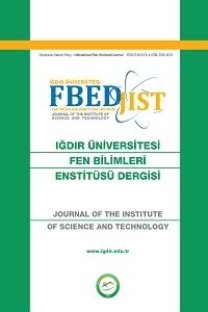Wharton Jel Kaynaklı Eksozom İzolasyonu: Metot Karşılaştırma Çalışması
Wharton Jel, Eksozom, İzolasyon Metotları
Wharton Gel-Derived Exosome Isolatıon: A Method Comparative Study
Wharton Gel, Exosome, Isolation Methods,
___
- Beeravolu, N., McKee, C., Alamri, A., Mikhael, S., Brown, C., Perez-Cruet, M., & Chaudhry, G. R. (2017). Isolation and characterization of mesenchymal stromal cells from human umbilical cord and fetal placenta. Journal of Visualized Experiments, 3(122). https://doi.org/10.3791/55224-v
- Bongso, A., & Fong, C.-Y. (2012). The therapeutic potential, challenges and future clinical directions of stem cells from the wharton’s jelly of a the human umbilical cord. Stem Cell Reviews and Reports, 9(2), 226–240. https://doi.org/10.1007/s12015-012-9418-z
- Brydson, R., Brown, A., Hodges, C., Abellan, P., & Hondow, N. (2015). Microscopy of nanoparticulate dispersions. Journal of Microscopy, 260(3), 238–247. https://doi.org/10.1111/jmi.12290
- Dragovic, R. A., Gardiner, C., Brooks, A. S., Tannetta, D. S., Ferguson, D. J. P., Hole, P., & Sargent, I. L. (2011). Sizing and phenotyping of cellular vesicles using Nanoparticle Tracking Analysis. Nanomedicine: Nanotechnology, Biology and Medicine, 7(6), 780–788. https://doi.org/10.1016/j.nano.2011.04.003
- Gangoda, L., Boukouris, S., Liem, M., Kalra, H., & Mathivanan, S. (2014). Extracellular vesicles including exosomes are mediators of signal transduction: Are they protective or pathogenic? Proteomics, 15(2–3), 260–271. https://doi.org/10.1002/pmic.201400234
- Greening, D. W., Gopal, S. K., Xu, R., Simpson, R. J., & Chen, W. (2015). Exosomes and their roles in immune regulation and cancer. Seminars in Cell & Developmental Biology, 40, 72–81. https://doi.org/10.1016/j.semcdb.2015.02.009 György, B., Szabó, T. G., Pásztói, M., Pál, Z., Misják, P., Aradi, B., & Buzas, E. I. (2011). Membrane vesicles, current state-of-the-art: Emerging role of extracellular vesicles. Cellular and Molecular Life Sciences, 68(16), 2667–2688. https://doi.org/10.1007/s00018-011-0689-3
- Harding, C., Heuser, J., & Stahl, P. (1983). Receptor-mediated endocytosis of transferrin and recycling of the transferrin receptor in rat reticulocytes. Journal of Cell Biology, 97(2), 329–339. https://doi.org/10.1083/jcb.97.2.329
- Hassan, G., Kasem, I., Soukkarieh, C., & Aljamali, M. (2017). A simple method to isolate and expand human umbilical cord derived mesenchymal stem cells: Using explant method and umbilical cord blood serum. International Journal of Stem Cells, 10(2), 184–192. https://doi.org/10.15283/ijsc17028
- Johnstone, R. M., Adam, M., Hammond, J. R., Orr, L., & Turbide, C. (1987). Vesicle formation during reticulocyte maturation. Association of plasma membrane activities with released vesicles (exosomes). Journal of Biological Chemistry, 262(19), 9412–9420. https://doi.org/10.1016/s0021-9258(18)48095-7
- Karaöz, E., Çetinalp Demircan, P., Erman, G., Güngörürler, E., & Eker Sarıboyacı, A. (2016). Comparative Analyses of Immune -Suppressive Characteristics of Bone-Marrow, Wharton’s Jelly a nd Adipose-Tissue Derived Human MSCs. Turkish Journal of Hematology, 34(3). https://doi.org/10.4274/tjh.2016.0171
- Mittelbrunn, M., Gutiérrez-Vázquez, C., Villarroya-Beltri, C., González, S., Sánchez-Cabo, F., González, M. Á., … Sánchez-Madrid, F. (2011). Unidirectional transfer of microRNA-loaded exosomes from T cells to antigen-presenting cells. Nature Communications, 2(1). https://doi.org/10.1038/ncomms1285
- Murk, J.L., Stoorvogel, W., Kleijmeer, M. J., & Geuze, H. J. (2002). The plasticity of multivesicular bodies and the regulation of antigen presentation. Seminars in Cell & Developmental Biology, 13(4), 303–311. https://doi.org/10.1016/s1084952102000605
- Pirjali, T., Azarpira, N., Ayatollahi, M., Aghdaie, M.H., Geramizadeh, B., & Talai, T., (2013). Isolation and characterization of human mesenchymal stem cells derived from human umbilical cord Wharton’s jelly and amniotic membrane Int. J. Org. Transplant. Med. 4 (3) 111 – 116.
- Rasmussen, M. K., Pedersen, J. N., & Marie, R. (2020). Size and surface charge characterization of nanoparticles with a salt gradient. Nature Communications, 11(1). https://doi.org/10.1038/s41467-020-15889-3
- Simpson, R. J., Lim, J. W., Moritz, R. L., & Mathivanan, S. (2009). Exosomes: Proteomic insights and diagnostic potential. Expert Review of Proteomics, 6(3), 267–283. https://doi.org/10.1586/epr.09.17
- Sun, D., Zhuang, X., Grizzle, W., Miller, D., & Zhang, H.-G. (2011). Abstract 4446: A novel nanoparticle drug delivery system: The anti-inflammatory activity of curcumin is enhanced when encapsulated in exosomes. Cancer Research, 71(8_Supplement), 4446–4446. https://doi.org/10.1158/1538-7445.am2011-4446
- Thery, C., Amigorena, S., Raposo, G., & Clayton, A. (2006). Isolation and characterization of exosomes from cell culture supernatants and biological fluids. Current Protocols in Cell Biology, 30(1). https://doi.org/10.1002/0471143030.cb0322s30
- Thery, C., Ostrowski, M., & Segura, E. (2009). Membrane vesicles as conveyors of immune responses. Nature Reviews Immunology, 9(8), 581–593. https://doi.org/10.1038/nri2567
- Tofino-Vian, M., Guillén, M. I., Pérez del Caz, M. D., Castejón, M. A., & Alcaraz, M. J. (2017). Extracellular vesicles from adipose-derived mesenchymal stem cells downregulate senescence features in osteoarthritic osteoblasts. Oxidative Medicine and Cellular Longevity, 2017, 1–12. https://doi.org/10.1155/2017/7197598 Troyer, D. L., & Weiss, M. L. (2007). Concise review: Wharton’s jelly-derived cells are a primitive stromal cell population. Stem Cells, 26(3), 591–599. https://doi.org/10.1634/stemcells.2007-0439
- Vergauwen, G., Dhondt, B., Van Deun, J., De Smedt, E., Berx, G., Timmerman, E., & Hendrix, A. (2017). Confounding factors of ultrafiltration and protein analysis in extracellular vesicle research. Scientific Reports, 7(1). https://doi.org/10.1038/s41598-017-02599-y
- Vidal, M., Sainte-Marie, J., Philippot, J. R., & Bienvenue, A. (1989). Asymmetric distribution of phospholipids in the membrane of vesicles released during in vitro maturation of guinea pig reticulocytes: Evidence precluding a role for? aminophospholipid translocase? Journal of Cellular Physiology, 140(3), 455–462. https://doi.org/10.1002/jcp.1041400308
- Widowati, W., Wijaya, L., Bachtiar, I., Gunanegara, R. F., Sugeng, S. U., Irawan, Y. A., & Widodo, A.M. (2014). Effect of oxygen tension on proliferation and characteristics of Wharton’s jelly-derived mesenchymal stem cells. Biomarkers and Genomic Medicine, 6(1), 43–48. https://doi.org/10.1016/j.bgm.2014.02.001
- Yusoff, Z., Maqbool, M., George, E., Hassan, R.M.D & Ramasamy, R. (2016). Generation and characterisation of human umbilical cord derived mesenchymal stem cells by explant method Medical Journal of Malaysia, 71 (3) 105-110.
- Zhang, Y., Liu, Y., Liu, H., & Tang, W. H. (2019). Exosomes: Biogenesis, biologic function and clinical potential. Cell & Bioscience, 9(1). https://doi.org/10.1186/s13578-019-0282-2
- ISSN: 2146-0574
- Yayın Aralığı: 4
- Başlangıç: 2011
- Yayıncı: -
Enhancement of Strawberry Marmalade with Crab Apple (Malus floribunda) Anthocyanins
Ayca GÜLHAN, Hacer ÇOKLAR, Mehmet AKBULUT
Ali KAYGISIZ, Recep AYDIN, Celil Yaşar ÖZDEMİR
Okan BAYRAM, Emel MORAL, Fethiye GÖDE
DA Motor Konum Kontrolü için LQR+I ve Bulanık Mantık Denetleyici Tasarımı
Atakan AKSOY, İslam AKSOY, Tuğçe YAREN, Selçuk KİZİR
Tarım ve Mera Alanlarında Rüzgâr ve Güneş Enerji Sistemleri Kurulması Hakkında Değerlendirmeler
Emre BIÇAKÇI, Cahit BALABANLI, Emrah ACAR
Kolon Kanserinde IL-6 Sitokinin Karbonik anhidraz III Gen İfadesi Üzerindeki Etkisinin İncelenmesi
